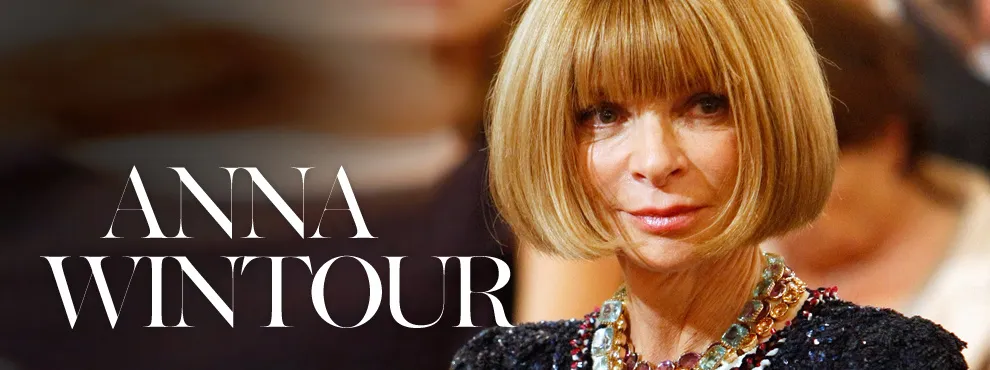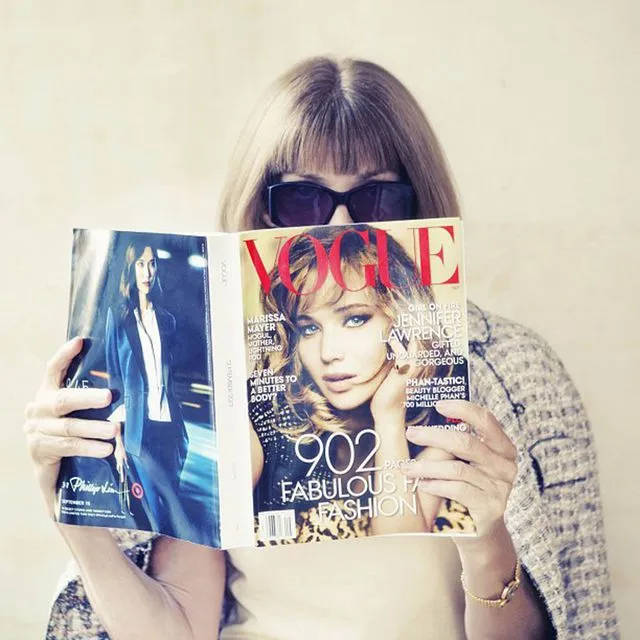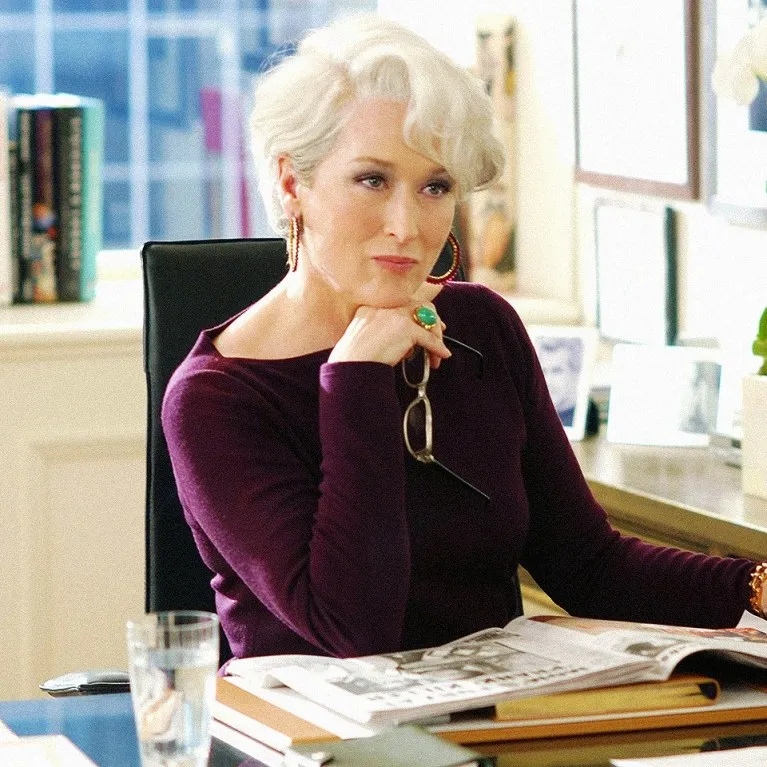Anna Wintour
I published a few days ago a photo of the Queen of England at her first fashion week at 92 and she was sitting next to Anna Wintour. You can imagine that it's not just anyone to sit next to the Queen. But who is this woman?

Anna Wintour was born on November 3, 1949 in London, she is the editor-in-chief of the American edition of Vogue magazine since 1988 and the artistic director of Condé Nast since 2013. She currently lives in New York.
In London, she is interested from adolescence to fashion by advising her father, editor of the Evening Standard, on how to encourage young Londoners of the mid-1960s to buy his newspaper. She leaves high school at sixteen to enter journalism in London. She will work in New York in the 1970s for various magazines including New York and House & Garden, before returning to England at the British edition of Vogue and finally for his American counterpart in New York.
Anna Wintour has become an icon of fashion over time. His bob cut and his sunglasses are now commonplace at the forefront of the biggest fashion shows.
Today, she is an institution in the world of fashion, just like her magazine. World renowned for discovering new trends and launching young designers, its coldness and its demanding have earned it the nickname Nuclear Wintour (play on the word nuclear winter). In 2003, one of her former personal assistants, Lauren Weisberger, wrote a novel inspired by her experience, The Devil Wears Prada. The latter was adapted to the cinema in 2006, with Meryl Streep in the role of Miranda Priestly, whose character is largely inspired by Anna Wintour. She is also the central figure in the documentary The September Issue (2009).
History

His father, Charles Vere Wintour, was an editor for the Evening Standard tabloid. Her mother, Eleanor Trego Baker, daughter of a Harvard law professor, was married to Anna's father from 1940 to 1979. Her name is inspired by her maternal grandmother, Anne Gilkyson Baker. His mother-in-law is Audrey Slaughter, an editor who has founded several English magazines such as Honey and Petticoat.
Anna Wintour has four brothers and sisters, three of whom are still alive: James Charles, elected to the council of an English municipality, Nora Hilary Wintour, deputy general secretary of the international trade union federation for the public service unions in Geneva and Patrick Wintour , political reporter at the Guardian and the Observer. His older brother, Gerald Jackson Wintour, died in 1951, knocked over by a car while on his way to school by bike.
She attended school at North London Collegiate School, where she challenged the uniform in effect by shortening her skirt. At fourteen, she adopted the Bob cut, which has since become her trademark. In hip London in the 1960s, she took a close interest in fashion by following Cathy McGowan's Ready Steady Go !, and her father regularly consults her on how to increase her readership among young people.
She begins very early to conquer men older than her. For example, at the age of fifteen, she has a brief affair with the writer Piers Paul Read, who was 24 years old. At the end of her teenage years, she has a love affair with social writer Nigel Dempster, and they are seen together in all the big London parties.

Anna Wintour gets her first job in the trendy Biba shop thanks to her father, who was fifteen. The following year, she left North London Collegiate School. She decides to stop studying to start a training at Harrods. However, her parents forced her to take a fashion class at a school near the store, but she quickly gave up, claiming that fashion was not learned. At that time, she continues to associate with older men such as Peter Guitterman, the son-in-law of London Philharmonic Orchestra conductor Georg Solti. Another of his conquests, Richard Neville, gives him a first glimpse of his future career with the magazine Oz.
She took her first steps into the world of fashion journalism when she entered the British edition of Harper's Bazaar magazine in 1970. Indeed, the magazine, which has just merged with Queen to become, for a time, Harper's & Queen, looking for editorial assistants. She then makes it clear to her colleagues that her ambition is to become an editor at Vogue. At that time, she introduced model Annabel Hodin, a former classmate, and used her connections to work with renowned photographers such as Helmut Newton. She left the magazine in 1975 because of a misunderstanding with the new editor, Min Hogg, a position that Anna herself would have liked to obtain. She then goes to New York with her companion, freelance journalist and playboy Jon Bradshaw.
Anna joined the American edition of Harper's Bazaar in 1975 as a fashion editor. His innovative photos cause conflicts with the editor, Tony Mazzola, which is worth it to be dismissed after nine months. She meets Bob Marley, introduced by a friend of Bradshaw, and disappears with him for a week.
Several months later, Bradshaw helped her land her first position as Fashion Editor at Viva magazine.
She works there for two years and will rarely report this episode, given the link of this magazine with Penthouse. This is the first time she has a personal assistant, and there will begin her reputation as a demanding boss.
Anna Wintour returned to work in 1980, succeeding Elsa Klensch as fashion editor for a new women's magazine, Savvy. The magazine sought to appeal to active, career-oriented and independent women who could finance their purchases on their own salary.
The following year, she became fashion editor at New York magazine, a milestone in her career. Indeed, the accumulation of articles and fashion photos she has produced so far are starting to attract attention. She becomes the protégé of the publisher Edward Kosner, which allows him some sprains to rules that it considers too strict, which earned him the wrath of his colleagues. He lets her work on other sections of the magazine, and realizes how much the presence of a celebrity on the cover can affect the magazine's sales.
Polly Mellen, a colleague of Harper's & Queen, arranges an interview with Vogue editor Grace Mirabella. But it is shortened because Anna quickly makes it clear that she wants to take his place.
While in New York, his work is spotted by Alexander Liberman, managing editor of the Condé Nast group, which owns Vogue. In 1983, she became Creative Director, a position specially created for Anna and allowing her to double her salary. Since her duties are not clearly defined, she often allows herself to change the orientation of the magazine without referring to the editor, Grace Mirabella, which causes tensions with other journalists.
In 1985, she replaced Beatrix Miller as Editor-in-Chief of the British edition of Vogue. She took charge in April 1986, shortly after the birth of her son Charlie. His company finances his house, his governess as well as many flights in Concorde. In fact, her husband lives in New York, where he is working on a research project on teen suicide.
Anna Wintour is a major contributor to the evolution of the traditionally eccentric British edition of Vogue, bringing it closer to the concept of American publishing and also inspired by the Savvy magazine model.
She is interested in the world of business and money. She does not have time to go shopping anymore. Wintour is reshaping his team and exercising more control over the magazine than his predecessors.
Liz Tilberis replaces her when she takes over the management of House & Garden magazine in New York. Indeed, the latter was let ahead by the magazine Architectural digest. She gets carte blanche to right her situation. Wintour takes this opportunity to make radical changes in staff and the look of the magazine. All these changes do not benefit the magazine. When it is renamed HG on the cover of the March 1988 issue, many long-time subscribers think it's a new magazine and put it aside while waiting for their regular magazine. Finally, the magazine suffers numerous unsubscriptions, and when fashion advertisers invest it, many traditional advertisers pull out.

After ten months, the Condé Nast group transferred Anna Wintour to a position she had been waiting for for a long time: Vogue's management. In Grace Mirabella's time, the magazine was more about lifestyle than about fashion. She will revolutionize the magazine and publish, for the first issue under his responsibility a cover with Michaela Bercu in jeans, and a cover with a black model for the first special fashion.
Since taking over the management of the magazine, sales have increased dramatically, making Vogue the leader in all global editions and a major provider of commercials.
In December 2012, she is expected, for having contributed to the re-election of Barack Obama, to be appointed ambassador of the United States in France or in the United Kingdom. Finally, cumulating with her position of editor-in-chief at Vogue, she was appointed at the beginning of the following year as artistic director of all the publications of the Condé Nast group.
Private life
She has two children Charles and Katherine, who blogs for the Daily Telegraph. She divorced in 1999, gossip says it's an adventure with millionaire Shelby Bryan that would have ended the marriage.
Anna Wintour is also a philanthropist. She serves as trustee for the Metropolitan Museum of Art in New York. Wintour started the CFDA / Vogue Fund, to encourage, support and mentor unknown designers. She has also raised a lot of money to help families who were victims of the September 11 terrorist attacks and raised more than $ 10 million for the fight against AIDS since 1990, at many events.
She organizes "Americans in Paris" parties at the US Embassy in France to promote American talent.
The devil wears Prada

Lauren Weisberger's novel, which was Anna Wintour's assistant, has heroine Andrea "Andy" Sachs, a newly graduated young woman with literary ambitions. Andy joins the legendary editor-in-chief Miranda Priestly, whose character bears many similarities to Anna Wintour; she is English, has two children and supports the Metropolitan Museum of Art.
Priestly is represented as a tyrant who makes impossible demands to his subordinates by giving them little information and a limited time and not bearing any delay in the tasks it assigns to them, then blaming them for their failures.
When it was suggested that his book was a key novel where the frame was that of Vogue magazine and the character of Miranda Priestly, Anna Wintour, Lauren Weisberger denied, even giving Anna Wintour herself a furtive appearance at the end of the book .
The romantic portrait of "Wintour / Priestly" is not totally negative. Andrea notes that Miranda manages to take on the difficult task of making all the major editorial decisions of a leading fashion magazine every month.
https://fr.onmovies.to/film/Bl/The-Devil-Wears-Prada?ep=2305.
I advise you, it's a pretty nice movie.
Before her publication, Anna Wintour told The New York Times: "I always enjoy a piece of fiction. I have not decided yet whether I will read it or not. "
However, the success of the book would be less due to its satirical dimension than to a reading in the first degree. Neither Vogue nor any other Conde Nast publication echoed the book. When the film was made, a magazine of the company, The New Yorker, published a comparison that denigrated the book. Janet Maslin of The New York Times avoided mentioning Anna Wintour's name in one of the book's two negative reviews.
The film, released in 2006, was a box-office success around the world, consolidating despite itself the status of "star" Anna Wintour.